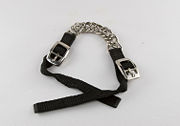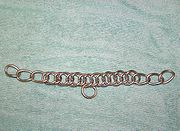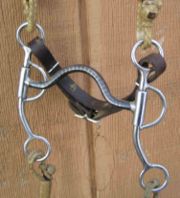
Curb chain
Encyclopedia


Horse tack
Tack is a term used to describe any of the various equipment and accessories worn by horses in the course of their use as domesticated animals. Saddles, stirrups, bridles, halters, reins, bits, harnesses, martingales, and breastplates are all forms of horse tack...
used on any type of curb bit
Curb bit
A curb bit is a type of bit used for riding horses that uses lever action. It includes the pelham bit and the Weymouth curb along with the traditional "curb bit" used mainly by Western riders....
. It is a flat linked chain or strap that runs under the chin groove of the horse, between the bit shank purchase arms. It has a buckle or hook attachment and often has a "fly link" in the middle to apply a lip strap
Lip strap
A lip strap is a piece of horse tack used sometimes on some types of curb bit and Pelham bits. The lip strap runs between the bit shank lever arms and passes through a special center ring on a curb chain...
. Normally the horse is bridle
Bridle
A bridle is a piece of equipment used to direct a horse. As defined in the Oxford English Dictionary, the "bridle" includes both the headstall that holds a bit that goes in the mouth of a horse, and the reins that are attached to the bit....
d with the curb chain undone, then the curb chain is done up.
Uses


Lever
In physics, a lever is a rigid object that is used with an appropriate fulcrum or pivot point to either multiply the mechanical force that can be applied to another object or resistance force , or multiply the distance and speed at which the opposite end of the rigid object travels.This leverage...
action of a curb bit. Additionally, it also helps to keep the bit steady and in place within the mouth, and helps to hold a lip strap
Lip strap
A lip strap is a piece of horse tack used sometimes on some types of curb bit and Pelham bits. The lip strap runs between the bit shank lever arms and passes through a special center ring on a curb chain...
in place.
Action
The curb chain applies pressure to the curb groove under a horse's chin when the curb rein of the bit is used. When the curb rein is pulled, the shank of the bit rotates back towards the chest of the horse and the cheek (upper shank) of the bit rotates forward (since it is a lever arm). The curb chain is attached to the rings at the end of the cheek, so, as the cheek moves forward, the chain is pulled and tightened in the curb groove. Once it comes in contact with the curb groove of the horse it acts as a fulcrum, causing the cannons of the bit mouthpiece to push down onto the horse's bars, thus amplifying the bit's pressure on the bars of the horse's mouth.Adjustment
The tightness of the curb chain therefore has a great effect on the action of the bit. If the bit is used without a curb chain, it loses its leverage action. If used with a loose curb chain, it allows the shanks to rotate more before the curb chain is tight enough to act as a fulcrum and exert pressure. This extra rotation can warn the horse before pressure is exerted on his mouth, so he may respond beforehand. However, a very loose curb chain can be undesirable, especially if the port is high. It allows the bit to rotate in the mouth too much, causing the port to become more vertical and press against the palate, which is painful and can damage the mouth, and can cause the horse to gape. Additionally, it can completely nullify the correct action of the curb, making its use pointless.There are two undesirable consequences when using a very tight curb chain. First, the bit immediately exerts curb pressure and increased pressure on the bars as soon as pressure is applied to the reins. Therefore, a tight curb chain is much harsher, and provides less finesse in signaling the horse than a looser curb chain would, as the horse is never given a chance to respond before the bit pushes into his bars. Secondly, a very tight curb chain causes the mouthpiece to constantly push down on the sensitive tongue, never allowing the horse relief. In severe cases, the tongue can lose blood supply.
Most horsemen adjust the curb chain so it only comes into action when the shank rotates 45 degrees back. However, horsemen with skill and experience with the curb bit can adjust the chain to accommodate the needs of the individual horse and training situation. When in doubt, however, most suggest keeping the curb chain slightly looser.
The curb chain should be applied by twisting it clockwise on one hook until it is flat, and then attaching it to the other hook. A curb chain must NEVER be used twisted, as it can cause serious damage to the horse.

